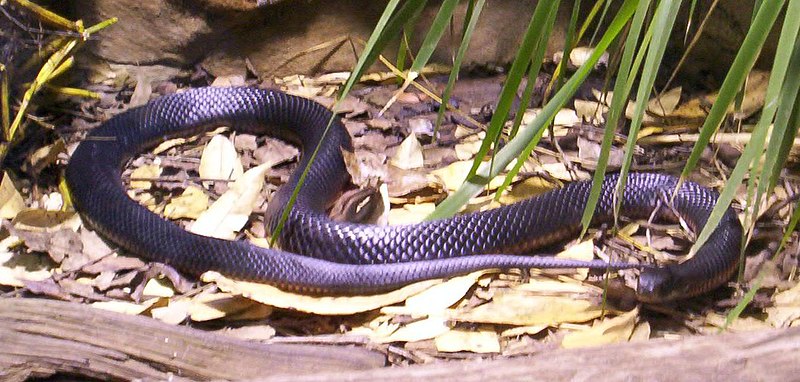Scientific Name: Pseudechis porphyriacus
"The red-bellied black snake's head is barely distinguishable from the body as there is no obvious constricted neck area. This snake is dangerously venomous but bites are rare because it is usually a placid and fairly docile snake, preferring to enact a lengthy bluff display with flattened neck and deep hisses rather than bite. It grows to a length of 2.5 metres, and is a very distinctive snake because of its simple and unvarying coloration. The upper surface of this snake is glossy black while the belly is light pink to brilliant red. The only other snake with a similar appearance is the small-eyed snake (Cryptophis nigrescens), but in this species the red belly colour is not visible unless the snake is turned over, where as the red of the red-bellied black snake extends up the lower flanks.
Habitat:
The red-bellied black snake is commonly associated with streams, rivers, creeks, swamps and other wetland areas. They may wander into well vegetated private gardens which are adjacent to water courses.
Diet:
The red-bellied black snake specializes in eating frogs but they will also eat mice, lizards, other small mammals, birds and occasionally fish."
Source: Australian Reptile Park
My neighbour shares a property with a friend at Murrumbateman - an attractive area well known as a grape growing area that produces the best of Australia's award winning cold climate wines - about 25 klms from Yass. While his friend runs it as a small allottment farming venture, my neighbour does a John Gray Going Gently and runs a menagerie of animals out there.
They have a couple of ex-race horses that never made the grade at the tracks which they use to ride around the property and then there is "Bruce", the adopted ram raised from a lamb.
Bruce
"Eric" the black miniture pig who was obtained as a mate for "Piglet" their other miniture pig. As well, there are assorted chickens, a rooster, some geese and ducks.
"Bruce's" mate is "Nikki". She is a huge but adorable hound and as strong as an ox:
Nikki
There are also two small terriers - the latter two who spend every waking moment tearing around barking ceaselessly at anyone or anything that wakes them from their slumbers.
Anyway, with 'fall' well and truly upon us my houseyard is rapidly getting a coverage of leaves, especially from my flowering pear tree.
I've been raking these up and adding them into my compost bins located behind the shadehouse and against the rear fence - the trelliss, barely discernable in the front of the bins grow three thornless white miniture rose vines:
That's my shadehouse with my black olive tree in the foreground and you can just make out my new lemon tree behind it and to the right of picture is a native shrub, a crimson bottlebrush - a good 'nectar' flowering shrub which attracts the native bees in the warmer weather.
My bins were full of leaf mulch and over-brimming, so I asked my neighbour if he could fetch me a couple of bags of horse manure from the property at Murrumbateman. I would use the weight of the semi-decomposed horse manure to push the leaf matter down and allow me more room in the bins. He brought me three bags on Sunday night and they have been sitting in our alcove next to the driveway gate until today, when I decided to wheel them down the yard to top up the compost bins.
The last of the three bags of horse manure
All went well as I emptied the first bag into a few of the bins and then I collected the second of the three bags. The twine he used to tie this one off with was knotted, so I sliced it with a Stanley knife but I overdid it and cut into the top of the fibrous oaten chaff bag. I felt something move under my hand and when I looked closer a large area of the under-surface of the bag was 'squirming'. I slit the bag a little more and prepared to jump out of the way. Sure enough, out slithered a redbelly black snake, about four to five feet long. It must have made a home in the stable compost pile and had been shovelled into the bag without being noticed. Fortunately for me, although the RBBS is not a seriously venomous, its venom is capable of causing significant morbidity but it is not generally fatal and less venomous than other deadly Australian snakes.
This guy was still pretty 'drowsy' from his disturbed hibernation, so I was able to throw a bucket over the top of him and after checking for any holes I emptied him into a bag which I tied off thoroughly.
RBBS in a bag - a 'take-away'!
As we currently have a problem with field mice multiplying and occupying homes, sheds and outhouses, I'll give him back to my neighbour tonight and he can return it back to his own home environment.









5 comments:
thanks for the mention JohnO
your garden is NOOO bloody neat!
soooo not nooooo
Nice of you to go gently with the poor fellow.
Far too many people would take to him (or her) with a spade.
Al, snakes are a 'protected species' under our environmental laws. Slowly, people are starting to learn to leave them alone and they'll go their own way. I could have called the Ranger but our Ranger would merely say "You are kidding! You can handle the buggers better thaan I can!"
Thank you JohnG - mostly the neatness is due to Rhonda who spends many of her off-duty hours in the garden, weeding and digging. I just try to do the 'Hard Yakka'!
Post a Comment